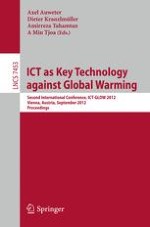2012 | Book
ICT as Key Technology against Global Warming
Second International Conference, ICT-GLOW 2012, Vienna, Austria, September 6, 2012. Proceedings
Editors: Axel Auweter, Dieter Kranzlmüller, Amirreza Tahamtan, A Min Tjoa
Publisher: Springer Berlin Heidelberg
Book Series : Lecture Notes in Computer Science
